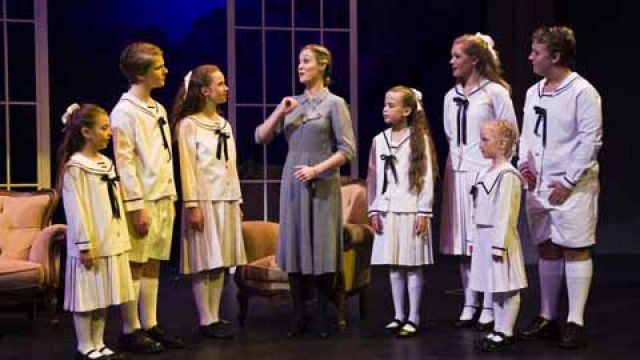The Sound of Music
Captivating leading lady Kelly Pythian suggested, from her first pure confident notes, exuding charm and stage presence, that Maria, the lynch-pin role of this classic Rodgers and Hammerstein musical was in splendid hands.
She went on to build an engaging characterization and warm, natural rapport with all she worked with, and sang the huge proportion of the score that fell to her impressively.
 Maria’s rapport with the Von Trapp children is central; without it, forget even attempting The Sound of Music. Well, it was genuine and endearing in this production – you felt sure that a good deal of bonding had gone on during rehearsal, creating individual relationships with Maria, and within this little clan. The harmony and unity took musical form in the delivery of their well-loved songs.
Maria’s rapport with the Von Trapp children is central; without it, forget even attempting The Sound of Music. Well, it was genuine and endearing in this production – you felt sure that a good deal of bonding had gone on during rehearsal, creating individual relationships with Maria, and within this little clan. The harmony and unity took musical form in the delivery of their well-loved songs.
They’re great kids, led by Ashleigh Rubenach, a warm vivacious young performer to watch out for, as Leisl. The scenes between Ashleigh and Jonathan Holme, as telegraph boy Rolf, were as good as I have ever seen them, with a terrific mix of humour, and the innocence of young love.
All the children had strong, clear, believable individual personalities. There always seems to be an adorable kid to play the youngest, Gretl, and Laura Fisher is as cute as they come.
 At first glance, Jeremy Curtin seemed marginally younger than I’d imagine for a naval captain 20 years after the First World War, but youthful look aside, he credibly captured the range of the role of Captain Von Trapp, from stern disciplinarian to loving father. His relationship with Maria was truthful and nicely developed, and the attraction between the two characters was clear.
At first glance, Jeremy Curtin seemed marginally younger than I’d imagine for a naval captain 20 years after the First World War, but youthful look aside, he credibly captured the range of the role of Captain Von Trapp, from stern disciplinarian to loving father. His relationship with Maria was truthful and nicely developed, and the attraction between the two characters was clear.
All round, you couldn’t ask to hear the score sung much better, including the other substantial and memorable portion that falls to the nuns, who did full justice to the more sacred sounding portion of the score, while How Do You Solve a Problem Like Maria was bright and appealing. Tisha Kelleman brought warmth and sincerity to the singing and general portrayal of Mother Abbess.
Character performances - Andrew Davis’s Max, a likeable, roguish pragmatist and Graham Bone’s butler Franz, outwardly stiff but with a strong underlying personality - contributed a great deal. Erin Hosking, as the other woman, Elsa, and Denise Abo, as the housekeeper, gave strong, lively supporting performances.
On the large stage of the impressive lyric theatre at Pymble Ladies College, a brand new Alpine backdrop looked quite stunning. The remainder of the scenery, achieved relatively minimally against that backdrop, was mostly effective, though when small inset scenes were used, tightened lighting focus was really needed, as the vast expanses of the stage felt very large, very bright and very obvious.
Annie Veitch’s direction generally delivered the narrative brightly and effectively, though one scene disappointed me. While the audience enjoyed the wonderful singing of the nuns’ chorus, there really wasn’t a convincing wedding scene for Maria and the Captain. The nuns’ chorus was effectively a downstage stand-and-deliver concerted performance, when it could have been far more rewardingly integrated into the storytelling of this joyous moment.

Congratulations to Gerard Plummer and his splendid orchestra, and to Loud and Clear for the sound mix. With the orchestra in a genuine pit, we enjoyed something elusive in community theatre – a balanced, full theatre sound all night.
The verdict? Just when I thought I was probably Sound-of-Music’d out, Chatswood’s production sucked me in one more time.
Neil Litchfield
Photographer: Alan Roy
Subscribe to our E-Newsletter, buy our latest print edition or find a Performing Arts book at Book Nook.

